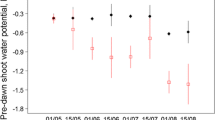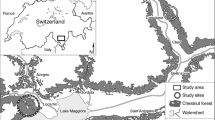Abstract
Key message
Biomass allocation in Castanea sativa varies according to the environmental conditions. Specifically, leaf-to-sapwood area ratio is higher on sites with good water supplies and lower in water-stressed conditions.
Abstract
Ecological plasticity allows organisms to adapt and to cope with environmental conditions. This is a key trait for species with long live span, which will probably be more vulnerable to changing climate because of their lower adaptation potential via natural selection. We studied the case of the sweet chestnut tree, a naturalized forest species in many European mountain areas, where it grows on very different climates and sites. This raises the question of its adaptation capacity to very different environmental conditions. To test this hypothesis, we applied the pipe model approach for analysing the variation in the leaf-to-sapwood area ratio (A L:A S) in 82 chestnut trees growing in very different site conditions (e.g., water-stressed convex vs. water-rich concave sites). We used linear regression analyses to model the A L:A S relationship to environmental and dendrometric parameters. Results confirm that A L:A S is significantly higher when trees grow on good nutrient- and water-supplied concave sites with respect to water-stressed, convex sites. Chestnut trees are thus able to vary their biomass allocation between sapwood and leaves to adapt their hydraulic characteristics to the site conditions. Trees seem to react to water-stressed conditions by allocating more biomass in the sapwood in respect to the leaves. A L:A S may thus represent a useful indicator of tree species plasticity and their adaptation potential to different environmental and climate conditions.



Similar content being viewed by others
References
Beccaro GL, Torello-Marinoni D, Binelli G, Donno D, Boccacci P, Botta R, Cerutti AK, Conedera M (2012) Insights in the chestnut genetic diversity in Canton Ticino (Southern Switzerland). Silvae Genet 6:292–300
Beers TW, Dress PE, Wensel LC (1966) Aspect transformation in site productivity research. J Forest 64:691–692
Belsley DA, Kuh E, Welsch RE (1980) Regression diagnostics: identifying influential data and sources of collinearity. Wiley, New York
Blaser P (1973) Die Bodenbildung auf Silikatgesteinim südlichen Tessin. Mitt Eidgenöss Forsch anst Wald Schnee Landsch 49:251–340
Blaser P, Zimmermann S, Luster J, Walthert L, Lüscher P (2005) Waldböden der Schweiz, vol 2. Birmensdorf, Eidgenössische Forschungsanstalt WSL, Bern, Hep Verlag, Regionen Alpen und Alpensüdseite 920 p
Bonan G (2002) Ecological climatology. Concepts and applications. Cambridge University Press, Cambridge
Callaway RM, Sala A, Keane RE (2000) Succession may maintain high leaf area: Sapwood ratios and productivity in old subalpine forests. Ecosystem 3:254–268
Chambers JM, Hastie TJ (1992) Statistical Models in S. Chapman & Hall, London
Conedera M, Krebs P (2008) History, present situation and perspective of chestnut cultivation in Europe. Acta Hortic 784:23–27
Conedera M, Manetti MC, Giudici F, Amorini E (2004) Distribution and economic potential of the sweet chestnut (Castanea sativa Mill.) in Europe. Ecol Medit 30:179–193
Conedera M, Fonti P, Nicoloso A, Meloni F, Pividori M (2009) Ribaltamento delle ceppaie di castagno: individuazione delle zone a rischio e proposte selvicolturali. Sherwood 154:15–18
Conedera M, Barthold F, Torriani D, Pezzatti GB (2010) Drought sensitivity of Castanea sativa: case study of summer 2003 in the southern alps. Acta Hortic (ishs) 866:297–302
Cruiziat P, Cochard H, Ameglio T (2002) Hydraulic architecture of trees: main concepts and results. Ann Forest Sci 59:723–752
Dai A (2012) Increasing drought under global warming in observations and models. Nat Clim Change 3:52–58
Delucia EH, Maherali H, Carey EV (2000) Climate-driven changes in biomass allocation in pines. Global Change Biol 6:587–593
Fernandez-Lopez J, Zas R, Diaz R, Villani F, Cherubini M, Aravanopoulos FA, Alizoti PG, Eriksson G, Botta R, Mellano MG (2005) Geographic variability among extreme European wild chestnut populations. Acta Hortic 693:181–186
Gehring E, Pezzatti GB, Krebs P, Mazzoleni S, Conedera M (2015) On the applicability of the pipe model theory on the chestnut tree (Castanea sativa Mill.). Trees Struct Funct 29:321–332
Grier CG, Running SW (1977) Leaf area of mature northwestern coniferous forests: relation to site water balance. Ecology 58:893–899
Hoadley RB (1980) Understanding wood: a craftsman’s guide to wood technology. Taunton Press Inc, USA
Hoffmann AA, Sgrò CM (2011) Climate change and evolutionary adaptation. Nature 470:479–485
Jose S, Gillespie AR (1996) Above ground production efficiency and canopy nutrient contents of mixed-hardwood forest communities along a moisture gradient in the central United States. Can J Forest Res 26:2214–2223
Kramer PJ (1983) Water relations of plants. Academic Press, USA
Krebs P, Koutsias N, Conedera M (2012) Modelling the eco-cultural niche of giant chestnut trees: new insights into land use history in southern Switzerland through distribution analysis of a living heritage. J Hist Geogr 38:372–386
Lauteri M, Scartazza A, Guido MC, Brugnoli E (1997) Genetic variation in photosynthetic capacity, carbon isotope discrimination and mesophyll conductance in provenances of Castanea sativa adapted to different environments. Funct Ecol 11:675–683
Lauteri M, Pluira A, Monteverdi MC, Brugnoli E, Villani F, Eriksson G (2004) Genetic variation in carbon isotope discrimination in six European populations of Castanea sativa Mill. originating from contrasting localities. J Evol Biol 17:1286–1296
Maherali H, Pockman WT, Jackson RB (2004) Adaptive variation in the vulnerability of woody plants to xylem cavitation. Ecology 8:2184–2199
Martin MA, Mattioni C, Cherubini M, Taurchini D, Villani F (2010) Genetic diversity in European chestnut populations by means of genomic and genic microsatellite markers. Tree Genet Genomes 6:735–744
Martinez-Vilalta J, Cochard H, Mencuccini M, Sterck F, Herrero A, Korhonen JFJ, Llorens P, Nikinmaa E, Nole A, Poyatos R, Ripullone F, Sass-Klaassen U, Zweifel R (2009) Hydraulic adjustment of Scots pine across Europe. New Phytol 184:353–364
Mattioni C, Cherubini M, Micheli E, Villani F, Bucci G (2008) Role of domestication in shaping Castanea sativa genetic variation in Europe. Tree Genet Genomes 4:563–574
Mattioni C, Martin MA, Pollegioni P, Cherubini M, Villani F (2013) Microsatellite markers reveal a strong geographical structure in European populations of Castanea sativa (Fagaceae), Evidence for multiple glacial refugia. Am J Bot 100:951–961
Mazzoleni S (1990) Relazioni tra aree fogliarie e superfici di conduzione nel fusto nell’analisi di gradienti ambientali. Linea Ecol, pp 27–30
Mazzoleni S, Dickmann DI (1988) Differential physiological and morphological responses of two hybrid Populus clones to water stress. Tree Physiol 4:61–70
Mencuccini M, Bonosi L (2001) Leaf/sapwood area ratios in Scots pine show acclimation across Europe. Can J Forest Res 31:442–456
Mencuccini M, Grace J (1994) Climate influences the leaf area/sapwood area ratio in Scots pine. Tree Physiol 15:1–10
Parmesan C (2006) Ecological and evolutionary responses to recent climate change. Annu Rev Ecol Evol Syst 37:637–669
Pividori M, Meloni F, Nicoloso A, Arienti R, Conedera M (2008) Ribaltamento delle ceppaie di castagno due casi di studio in cedui invecchiati Sherwood 14:17–21
Poyatos R, Martinez-Vilalta J, Cermak J, Ceulemans R, Granier A, Irvine J, Kostner B, Lagergren F, Meiresonne L, Nadezhdina N, Zimmermann R, Llorens P, Mencuccini M (2007) Plasticity in hydraulic architecture of Scots pine across Eurasia. Oecologia 153:245–259
Schlichting CD (1986) The evolution of phenotypic plasticity in plants. Annu Rev Ecol Syst 17:667–693
Schulte PJ, Hinckley TM, Stettler RF (1986) Stomatal response of Populus to leaf water potential. Can J Bot 65:255–260
Schwarz M, Lehmann P, Or D (2010) Quantifying lateral root reinforcement in steep slopes—from a bundle of roots to tree stands. Earth Surf Process Landf 35:354–367
Schwarz M, Cohen D, Or D (2012) Spatial characterization of root reinforcement at stand scale: theory and case study. Geomorphology 171–172:190–200
Shinozaki K, Yoda K, Hozumi K, Kira T (1964a) A quantitative analysis of plant form—the pipe model theory. I. Basic analyses. Jpn J Ecol 14:97–105
Shinozaki K, Yoda K, Hozumi K, Kira T (1964b) A quantitative analysis of plant form—the pipe model theory. II. Further evidence of the theory and its application in forest ecology. Jpn J Ecol 14:133–139
Spinedi F, Isotta F (2004) Il clima del Ticino. Dati statistiche e società 2:5–39
Sterck JS, Zweifel R, Sass-Klaassen U, Chowdhury Q (2008) Persisting soil drought reduces leaf specific conductivity in Scots pine (Pinus sylvestris) and pubescent oak (Quercus pubescens). Tree Physiol 28:529–536
UNEP—United nations environment programme (1992) In: Middleton N, Thomas DSG (eds) World atlas of desertification. Edward Arnold, London. ISBN 0 340 55512 2
Vertessy RA, Benyo RG, O’Sullivan SK, Gribben PR (1995) Relationships between stem diameter, sapwood area, leaf area and transpiration in a young mountain ash forest. Tree Physiol 15:559–567
Villani F, Pigliucci M, Lauteri M, Cherubini M, Sun O (1992) Congruence between genetic, morphometric and physiological data on differentiation of Turkish chestnut (Castanea sativa). Genome 35:251–256
Vogt J, Fonti P, Conedera M, Schröder B (2006) Temporal and spatial dynamic of stool uprooting in abandoned chestnut coppice forests. For Ecol Manage 235(1–3):88–95
Waring RH, Schroeder PE, Oren R (1982) Application of the pipe model theory to predict canopy leaf-area. Can J Forest Res 12:556–560
Whitehead D, Edwards WRN, Jarvis PG (1984) Conducting sapwood area, foliage area and permeability in mature trees of Picea sitchensis and Pinus contorta. Can J Forest Res 14:940–994
Acknowledgments
Our heartfelt thanks go to Franco Fibbioli, Nora Buletti, and Susan Lagger for their help during data collection.
Author information
Authors and Affiliations
Corresponding author
Ethics declarations
Funding
For this study, we only used our internal resources.
Conflict of interest
The authors declare that they have no conflict of interest.
Additional information
Communicated by U. Luettge.
Electronic supplementary material
Below is the link to the electronic supplementary material.
Rights and permissions
About this article
Cite this article
Gehring, E., Pezzatti, G.B., Krebs, P. et al. The influence of site characteristics on the leaf-to-sapwood area relationship in chestnut trees (Castanea sativa Mill.). Trees 30, 2217–2226 (2016). https://doi.org/10.1007/s00468-016-1447-9
Received:
Accepted:
Published:
Issue Date:
DOI: https://doi.org/10.1007/s00468-016-1447-9




